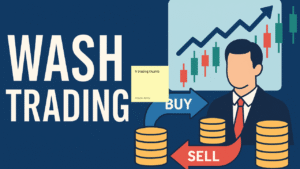 Wash Trading in the Stock Market: What It Is, Why It’s Illegal, and How to Spot It
Wash Trading in the Stock Market: What It Is, Why It’s Illegal, and How to Spot It
Wash trading is a deceptive and illegal practice in the stock market where a trader simultaneously buys and sells the same financial instrument to create the illusion of market activity. While it may seem like a technical loophole, wash trading undermines market integrity, misleads investors, and violates regulatory standards.
In this article, we’ll explore what wash trading is, how it works, why it’s banned, and how investors can protect themselves from its effects.
What Is Wash Trading?
Wash trading occurs when a trader executes buy and sell orders for the same security—often at the same price and time—with no intention of taking on market risk or changing their position. The goal is not profit, but rather to artificially inflate trading volume, manipulate prices, or create false signals of market interest.
Key Characteristics:
- The same asset is bought and sold simultaneously or within a short time frame.
- The trader’s net position remains unchanged.
- The trades are designed to mislead other market participants.
Wash trades can be executed by a single entity using multiple accounts or through collusion between brokers. In either case, the result is a distortion of genuine market data.
Why Do Traders Use Wash Trades?
Wash trading is typically used to manipulate perceptions of a stock’s liquidity, demand, or price movement. Here are the most common motivations:
1. Volume Inflation
High trading volume can attract attention from retail investors and algorithmic trading systems. Wash trades make a stock appear more active than it really is, drawing in unsuspecting buyers.
2. Price Manipulation
By repeatedly buying and selling a stock at slightly higher prices, traders can artificially inflate its price. This tactic is often used in “pump and dump” schemes, where the goal is to lure investors in before selling off at a profit.
3. Tax Avoidance
Some investors attempt to sell securities at a loss to claim a tax deduction, only to repurchase the same asset shortly after. This is known as a wash sale, and it’s disallowed by the IRS if the repurchase occurs within 30 days before or after the sale.
4. Market Spoofing
Wash trades can be used to spoof market interest, tricking other traders into reacting to false signals. This is especially common in high-frequency trading environments.
Is Wash Trading Illegal?
Yes. Wash trading is illegal under U.S. law and many international financial regulations. It violates the Commodity Exchange Act and is closely monitored by agencies such as:
- SEC (Securities and Exchange Commission)
- CFTC (Commodity Futures Trading Commission)
- FINRA (Financial Industry Regulatory Authority)
Violators can face:
- Civil fines
- Trading bans
- Criminal charges
- Reputational damage
In the crypto space, where regulation is still evolving, wash trading remains a major concern. Some decentralized exchanges and NFT platforms have been accused of inflating volume through wash trades to attract users or investors.
Real-World Examples of Wash Trading
Enron Scandal
Enron used wash trades to inflate its revenue figures, misleading shareholders and regulators. These trades had no economic substance but helped the company appear more profitable than it was.
Crypto Exchanges
A 2019 report by Bitwise Asset Management found that over 95% of reported Bitcoin trading volume on certain exchanges was likely fake or inflated through wash trading. This misled investors about the size and legitimacy of the crypto market.
Wash Sales and Tax Implications
The IRS defines a wash sale as selling a security at a loss and repurchasing the same or “substantially identical” security within 30 days. These losses are not deductible for tax purposes.
Example:
If you sell XYZ stock at a $1,000 loss on December 1 and buy it back on December 15, the IRS disallows the loss. Instead, the disallowed loss is added to the cost basis of the repurchased shares.
This rule is designed to prevent investors from gaming the system by realizing tax losses without truly exiting their positions.
How to Spot Wash Trading
While wash trades can be difficult to detect, here are some red flags:
- Unusual volume spikes without corresponding news or market events.
- Repeated trades between the same accounts or entities.
- Identical buy and sell orders executed within seconds.
- No change in net position after multiple trades.
Regulators use sophisticated surveillance tools to monitor trading patterns and flag suspicious activity. Retail investors should remain cautious and avoid chasing volume without understanding its source.
How to Avoid Wash Trades
Whether you’re a retail investor or a financial professional, here are some best practices:
- Avoid executing simultaneous buy/sell orders for the same asset.
- Use independent accounts for genuine trades.
- Consult a tax advisor before executing loss-harvesting strategies.
- Stay informed about regulatory updates, especially in emerging markets like crypto.
Wash Trading: Final Thoughts
Wash trading may seem like a technical detail, but its impact on market integrity is profound. It distorts price discovery, misleads investors, and erodes trust in financial systems. Whether you’re trading stocks, crypto, or derivatives, understanding and avoiding wash trades is essential for ethical and compliant investing.
By staying informed and vigilant, investors can protect themselves and contribute to a healthier, more transparent market environment.